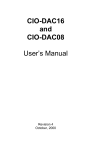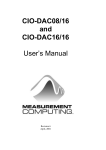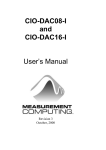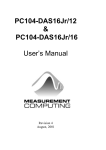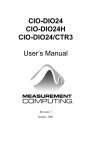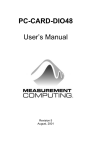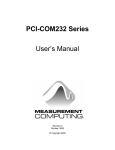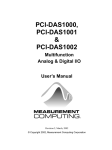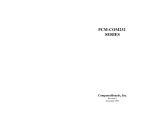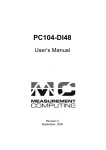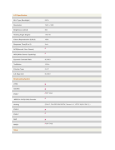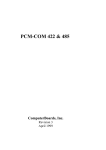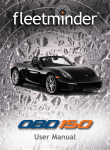Download CIO-DAS08/JR & CIO-DAS08/JR-AO
Transcript
CIO-DAS08/JR & CIO-DAS08/JR-AO Analog I/O and Digital I/O Board User’s Manual Revision 4 April, 2001 LIFETIME WARRANTY Every hardware product manufactured by Measurement Computing Corp. is warranted against defects in materials or workmanship for the life of the product, to the original purchaser. Any products found to be defective will be repaired or replaced promptly. LIFETIME HARSH ENVIRONMENT WARRANTYTM Any Measurement Computing Corp. product which is damaged due to misuse may be replaced for only 50% of the current price. I/O boards face some harsh environments, some harsher than the boards are designed to withstand. When that happens, just return the board with an order for its replacement at only 50% of the list price. Measurement Computing Corp. does not need to profit from your misfortune. By the way, we will honor this warranty for any other manufacture’s board that we have a replacement for! 30 DAY MONEY-BACK GUARANTEE Any Measurement Computing Corp. product may be returned within 30 days of purchase for a full refund of the price paid for the product being returned. If you are not satisfied, or chose the wrong product by mistake, you do not have to keep it. Please call for a RMA number first. No credits or returns accepted without a copy of the original invoice. Some software products are subject to a repackaging fee. These warranties are in lieu of all other warranties, expressed or implied, including any implied warranty of merchantability or fitness for a particular application. The remedies provided herein are the buyer’s sole and exclusive remedies. Neither Measurement Computing Corp., nor its employees shall be liable for any direct or indirect, special, incidental or consequential damage arising from the use of its products, even if Measurement Computing Corp. has been notified in advance of the possibility of such damages. MEGA-FIFO, the CIO prefix to data acquisition board model numbers, the PCM prefix to data acquisition board model numbers, PCM-DAS08, PCM-D24C3, PCM-DAC02, PCM-COM422, PCM-COM485, PCM-DMM, PCM-DAS16D/12, PCM-DAS16S/12, PCM-DAS16D/16, PCM-DAS16S/16, PCI-DAS6402/16, Universal Library, InstaCal, Harsh Environment Warranty and Measurement Computing Corp. are registered trademarks of Measurement Computing Corp. IBM, PC, and PC/AT are trademarks of International Business Machines Corp. Windows is a trademark of Microsoft Corp. All other trademarks are the property of their respective owners. Information furnished by Measurement Computing Corp. is believed to be accurate and reliable. However, no responsibility is assumed by Measurement Computing Corp. neither for its use; nor for any infringements of patents or other rights of third parties, which may result from its use. No license is granted by implication or otherwise under any patent or copyrights of Measurement Computing Corp. All rights reserved. No part of this publication may be reproduced, stored in a retrieval system, or transmitted, in any form by any means, electronic, mechanical, by photocopying, recording or otherwise without the prior written permission of Measurement Computing Corp. Notice Measurement Computing Corp. does not authorize any Measurement Computing Corp. product for use in life support systems and/or devices without the written approval of the President of Measurement Computing Corp. Life support devices/systems are devices or systems which, a) are intended for surgical implantation into the body, or b) support or sustain life and whose failure to perform can be reasonably expected to result in injury. Measurement Computing Corp. products are not designed with the components required, and are not subject to the testing required to ensure a level of reliability suitable for the treatment and diagnosis of people. (C) Copyright 2001, Measurement Computing Corp. HM CIO-DAS08_JR-AO.lwp TABLE OF CONTENTS 1 INTRODUCTION . . . . . . . . . . . . . . . . . . . . . . . . . . . . . . . . . . . . . . . . . . . . . . . . . . . . . . . . . . . . . . 1 1.1 ANALOG INPUTS AND OUTPUTS . . . . . . . . . . . . . . . . . . . . . . . . . . . . . . . . . . . . . . . . . . . . . 1.2 DIGITAL INPUTS AND OUTPUTS . . . . . . . . . . . . . . . . . . . . . . . . . . . . . . . . . . . . . . . . . . . . . 2 SOFTWARE INSTALLATION . . . . . . . . . . . . . . . . . . . . . . . . . . . . . . . . . . . . . . . . . . . . . . . . . . 3 HARDWARE INSTALLATION . . . . . . . . . . . . . . . . . . . . . . . . . . . . . . . . . . . . . . . . . . . . . . . . . 3.1 BASE ADDRESS . . . . . . . . . . . . . . . . . . . . . . . . . . . . . . . . . . . . . . . . . . . . . . . . . . . . . . . . . . . . . 3.2 INSTALLING THE CIO-DAS08/JR IN THE COMPUTER . . . . . . . . . . . . . . . . . . . . . . . . . . . . 4 CALIBRATION AND TEST . . . . . . . . . . . . . . . . . . . . . . . . . . . . . . . . . . . . . . . . . . . . . . . . . . . . . 5 SIGNAL CONNECTIONS . . . . . . . . . . . . . . . . . . . . . . . . . . . . . . . . . . . . . . . . . . . . . . . . . . . . . . . 6 REGISTER ARCHITECTURE . . . . . . . . . . . . . . . . . . . . . . . . . . . . . . . . . . . . . . . . . . . . . . . . . . 6.1 REGISTER LAYOUT . . . . . . . . . . . . . . . . . . . . . . . . . . . . . . . . . . . . . . . . . . . . . . . . . . . . . . . . . 6.2 A/D REGISTERS . . . . . . . . . . . . . . . . . . . . . . . . . . . . . . . . . . . . . . . . . . . . . . . . . . . . . . . . . . . . . 6.3 STATUS AND CONTROL REGISTER . . . . . . . . . . . . . . . . . . . . . . . . . . . . . . . . . . . . . . . . . . . 6.4 DIGITAL I/O CONTROL REGISTER . . . . . . . . . . . . . . . . . . . . . . . . . . . . . . . . . . . . . . . . . . . . 6.5 D/A CONTROL REGISTERS (CIO-DAS08/JR-AO ONLY) . . . . . . . . . . . . . . . . . . . . . . . . . . . 7 SPECIFICATIONS . . . . . . . . . . . . . . . . . . . . . . . . . . . . . . . . . . . . . . . . . . . . . . . . . . . . . . . . . . . . . 1 1 1 1 1 2 2 3 4 4 5 5 6 6 7 This page is blank. 1 INTRODUCTION The CIO-DAS08/JR combines analog inputs with digital input and output capability. The CIO-DAS08/JR-AO adds analog output capability. Throughout this manual, we will refer to the CIO-DAS08/JR except where the analog outputs are being discussed. In all other respects, the boards are identical. The CIO-DAS08/JR can be upgraded to a CIO-DAS08/JR-AO by purchasing and installing the CIO-DUAL-DAC chip set. See the “Upgrading the CIO-DAS08/JR” section. 1.1 ANALOG INPUTS AND OUTPUTS The CIO-DAS08/JR has eight single-ended analog inputs and can supply two analog outputs. Twelve-bit resolution at a fixed ±5V range is provided for both inputs and outputs. 1.2 DIGITAL INPUTS AND OUTPUTS There are eight inputs and eight outputs for sensing and controlling digital devices. They are port-addressable and are dedicated to either input or output. The digital outputs and inputs are TTL level. 2 SOFTWARE INSTALLATION The board has a set of address switches to set before installing the board in your computer. The simplest way to configure your board is to use the InstaCalTM program provided as part of your software package. InstaCalTM will show you how to configure the switches to match your application requirements, and will create a configuration file that your application software (and the Universal Library) will refer to so the software you use will automatically know the exact configuration of the board. Please refer to the Software Installation Manual regarding the installation and operation of InstaCalTM. The following information will allow you to do the hardware configuration of the board if you do not have immediate access to InstaCalTM and/or your computer. 3 3.1 HARDWARE INSTALLATION BASE ADDRESS The base address of the CIO-DAS08/JR is set by switching a bank of DIP switches on the board. This bank of switches is labeled ADDRESS and numbered 9 to 3 (Figure 3-1). Ignore the word ON and the numbers printed on the switch The address logic works by adding up the weights of individual switches to make up a base address. A switch is active when down. Shown to the right, switches 9 and 8 are down, all others are up. Weights 200h and 100h are active, equaling 300h base address. Refer to Table 3-1 for PC I/O addresses. Figure 3-1. Base Address Switches 1 Table 3-1. PC I/O Addresses HEX RANGE 000-00F 020-021 040-043 060-063 060-064 070-071 080-08F 0A0-0A1 0A0-0AF 0C0-0DF 0F0-0FF 1F0-1FF 200-20F 210-21F 238-23B 23C-23F 270-27F 2B0-2BF 3.2 FUNCTION 8237 DMA #1 8259 PIC #1 8253 TIMER 8255 PPI (XT) 8742 CONTROLLER (AT) CMOS RAM & NMI MASK (AT) DMA PAGE REGISTERS 8259 PIC #2 (AT) NMI MASK (XT) 8237 #2 (AT) 80287 NUMERIC CO-P (AT) HARD DISK (AT) GAME CONTROL EXPANSION UNIT (XT) BUS MOUSE ALT BUS MOUSE PARALLEL PRINTER EGA HEX RANGE 2C0-2CF 2D0-2DF 2E0-2E7 2E8-2EF 2F8-2FF 300-30F FUNCTION EGA EGA GPIB (AT) SERIAL PORT SERIAL PORT PROTOTYPE CARD 310-31F 320-32F 378-37F 380-38F 3A0-3AF PROTOTTYPE CARD HARD DISK (XT) PARALLEL PRINTER SDLC SDLC 3B0-3BB 3BC-3BF 3C0-3CF 3D0-3DF 3E8-3EF 3F0-3F7 3F8-3FF MDA PARALLEL PRINTER EGA CGA SERIAL PORT FLOPPY DISK SERIAL PORT INSTALLING THE CIO-DAS08/JR IN THE COMPUTER 1. Turn the power off. 2. Remove the cover of your computer. Please be careful not to dislodge any of the cables installed on the boards in your computer as you slide the cover off. 3. Locate an empty expansion slot in your computer. 4. Push the board firmly down into the expansion bus connector. If it is not seated fully it may fail to work and could short circuit the PC bus power onto a PC bus signal. This could damage the motherboard in your PC as well as the CIO-DAS08/JR. 4 CALIBRATION AND TEST The CIO-DAS08/JR is supplied with software for calibration and test in the InstaCal program under the CALIBRATE option. The CIO-DAS08/JR has a fixed input range and does not have any input amplification or gain/offset compensation electronics. When using the optional Universal Library, all compensation for gain/offset errors is done in software after the signal is acquired. The gain and offset calibration factors are stored in the CB.CFG file and applied to the analog samples after they are acquired. The calibration factors can be set as often as you like. Simply run the CALIBRATE option from the InstaCal menu. 2 5 SIGNAL CONNECTIONS NOTE: The Analog Out pins apply only to the CIO-DAS08/JR-AO. The CIO-DAS08/JR analog connector is a 37-pin, D-type connector accessible from the rear of the PC through the expansion backplate. The connector accepts female 37-pin, D-type connectors, such as the C37FF-2, a 2-foot cable with connectors. For quick and easy access to the board, use a CIO-MINI37 screw terminal board. 3 6 REGISTER ARCHITECTURE All of the programmable functions of the CIO-DAS08/JR are accessible through the control and data registers, which are explained here. We recommend programming with Universal Library rather than direct register programming. 6.1 REGISTER LAYOUT The CIO-DAS08/JR is controlled and monitored by writing to and reading from four consecutive 8-bit I/O addresses (eight consecutive addresses on the CIO-DAS08/JR-AO). The first address, or BASE ADDRESS, is determined by setting a bank of switches on the board. Most often, register manipulation is best left to ASSEMBLY language programs as most possible functions are implemented in Universal Library routines. Note that an X is an unspecified bit. There is no function associated with that bit position. All X bits should be masked out of reads. To write to or read from a register in decimal or HEX, the following weights apply: BIT POSITION 0 1 2 3 4 5 6 7 Table 6-1. Bit Weights DECIMAL VALUE 1 2 4 8 16 32 64 128 HEX VALUE 1 2 4 8 10 20 40 80 To write control words or data to a register, the individual bits must be set to 0 or 1 then combined to form a byte. Data read from registers must be analyzed to determine which bits are on or off. The registers and their function are listed on Table 6-2. Each register has eight bits which may constitute a byte of data or eight individual bit set/read functions. ADDRESS BASE BASE + 1 BASE + 2 BASE + 3 BASE + 4 BASE + 5 BASE + 6 BASE + 7 Table 6-2. Board Registers READ FUNCTION WRITE FUNCTION A/D Bits 8-11 (LSB) None A/D Bits 0 (MSB) - 7 Start 12 bit A/D conversion A/D status & MUX Address Set A/D channel Digital input, 8 bits Digital output, 8 bits D/A 0 LSB (-AO only) D/A 0 MSB (-AO only) D/A 1 LSB (-AO only) D/A 1 MSB (-AO only) 4 6.2 A/D REGISTERS BASE ADDRESS 7 6 A/D8 A/D9 5 A/D10 4 A/D11 LSB 3 X 2 X 1 X 0 X A read only register. On a read, it supplies the least significant four digits of the analog input data. These four bits of analog input data must be combined with the eight bits of analog input data in BASE + 1 to form a complete 12-bit number. The data is in the format 0 = minus FS (full scale); 4095 = +FS. BASE ADDRESS + 1 7 6 A/D0 A/D1 MSB 5 A/D2 4 A/D3 3 A/D4 2 A/D5 1 A/D6 0 A/D7 READ: The most significant A/D byte is read. WRITE: Any write to this register causes an immediate A/D conversion. A note of caution: Place several NO-OP instructions between consecutive 12-bit A/D conversions to avoid over-running the A/D converter. 6.3 STATUS AND CONTROL REGISTER BASE ADDRESS + 2 This register address is two registers, one for reading and one for writing. READ = STATUS 7 6 EOC X 5 X 4 X 3 X 2 ChAdd2 1 ChAdd1 0 ChAdd0 EOC = 1 the A/D is busy converting and data should not be read. EOC = 0 the A/D is not busy and data may be read. ChAdd 2 to ChAdd 0 is the current analog input multiplexer channel. The current channel is a binary coded number between 0 and 7 . WRITE = CONTROL 7 6 X X 5 X 4 X 3 X 2 ChAdd2 1 ChAdd1 0 ChAdd0 ChAdd 2 to ChAdd 0. Set the current channel address by writing a binary coded number between 0 and 7 to these three bits. 5 6.4 DIGITAL I/O CONTROL REGISTER BASE ADDRESS + 3 This address contains two registers, one for output and one for input. The output register is latched and holds the last value written to it. The input register is not latched. Each time the register is read the current state of the inputs is passed through this port into the computer. WRITE = Set digital output port, all bits. READ = Read digital input port, all bits and update both D/A channels simultaneously with the last values written to D/A output registers. 7 D7 6.5 6 D6 5 D5 4 D4 3 D3 2 D2 1 D1 0 D0 D/A CONTROL REGISTERS (CIO-DAS08/JR-AO ONLY) Each D/A is controlled by a pair of 8-bit write only registers. These registers contain the high nibble and the low byte of the D/A 12 bit control word. The value written to these two registers controls the output of the D/A chip. To update the D/A outputs with the values in the D/A output registers, read the register at BASE + 3. The D/A output range can be calculated as [(#/4096) * 10V] − 5V (for # between 0 and 4095 inclusive). The #/4096 is a proportion of the Full Scale Range, which is ±5V. D/A 0 CONTROL REGISTERS BASE ADDRESS + 4, DAC 0 LOW BYTE 7 6 5 DA7 DA6 DA5 4 DA4 3 DA3 2 DA2 1 DA1 0 DA0 LSB BASE ADDRESS + 5, DAC 0 HIGH BYTE 7 6 5 X X X 4 X 3 DA11 MSB 2 DA10 1 DA9 0 DA8 BASE ADDRESS + 6, DAC 1 LOW BYTE 7 6 5 DA7 DA6 DA5 4 DA4 3 DA3 2 DA2 1 DA1 0 DA0 LSB BASE ADDRESS + 7, DAC 1 HIGH BYTE 7 6 5 X X X 4 X 3 DA11 MSB 2 DA10 1 DA9 0 DA8 D/A 1 CONTROL REGISTERS 6 7 UPGRADING THE CIO-DAS08/JR To add analog output capability to a CIO-DAS08/JR, order and install the CIO-DUAL-DAC upgrade kit. Insert the AD7237 received in the CIO-DUAL-DAC kit into the socket labeled U13. Align the notch or dimple indicating pin 1 on the chip with the notch in the white silkscreen outline printed on the board at the U13 position. 7 8 SPECIFICATIONS Power consumption +5V +12V CIO-DAS08/JR CIO-DAS08/JR-AO -12V CIO-DAS08/JR CIO-DAS08/JR-AO 200 mA typical, 240A max 17 mA typical, 22mA max 27 mA typical, 35mA max 28 mA typical, 36mA max 28 mA typical, 36mA max Analog input section A/D converter type Resolution Number of channels Input ranges AD574 12 bits 8 single-ended ±5V A/D pacing Data transfer Software-polled Software-polled A/D conversion time Throughput 25 µs System-dependant Gain drift (A/D specs) Zero drift (A/D specs) Absolute maximum input voltage ±50 ppm/°C ±10 ppm/°C ±30V continuous Analog Output (CIO-DAS08/JR-AO Only) D/A converter type Resolution Number of channels Output Ranges AD7237 12 bits 2 ±5V D/A pacing Data transfer Software-paced Programmed I/O Offset error Gain error Differential nonlinearity Relative accuracy Monotonicity D/A Gain drift ±2 LSB typical, ±5LSB max ±2 LSB typical, ±5LSB max ±0.9 LSB max ±1 LSB max Guaranteed monotonic to 12 bits over temperature ±25 ppm/°C max Settling time (10V step to ±½LSB) Current Drive Output coupling Output impedance 10 µs max ±5 mA DC 0.5 Ohms max Miscellaneous Update DACs simultaneously 8 Digital Input / Output Digital Type Output Input Configuration Number of channels Output High Output Low Input High Input Low 74LS273 74LS244 8 fixed input, 8 fixed output 8 2.7 volts min @ −0.4 mA 0.5 volts max @ 8 mA 2.0 volts min, 7 volts absolute maximum 0.8 volts max, −0.5 volts absolute minimum Environmental Operating temperature range Storage temperature range Humidity 0 to 50°C −20 to 70°C 0 to 90% non-condensing 9 For your notes 10 EC Declaration of Conformity We, Measurement Computing Corp., declare under sole responsibility that the product: CIO-DAS08/JR CIO-DAS08/JR-AO Part Number Analog Input & Digital I/O Board Analog & Digital I/O Board Description to which this declaration relates, meets the essential requirements, is in conformity with, and CE marking has been applied according to the relevant EC Directives listed below using the relevant section of the following EC standards and other normative documents: EU EMC Directive 89/336/EEC: Essential requirements relating to electromagnetic compatibility. EU 55022 Class B: Limits and methods of measurements of radio interference characteristics of information technology equipment. EN 50082-1: EC generic immunity requirements. IEC 801-2: Electrostatic discharge requirements for industrial process measurement and control equipment. IEC 801-3: Radiated electromagnetic field requirements for industrial process measurements and control equipment. IEC 801-4: Electrically fast transients for industrial process measurement and control equipment. Carl Haapaoja, Director of Quality Assurance Measurement Computing Corporation 16 Commerce Boulevard, Middleboro, Massachusetts 02346 (508) 946-5100 Fax: (508) 946-9500 E-mail: [email protected] www. measurementcomputing.com
















